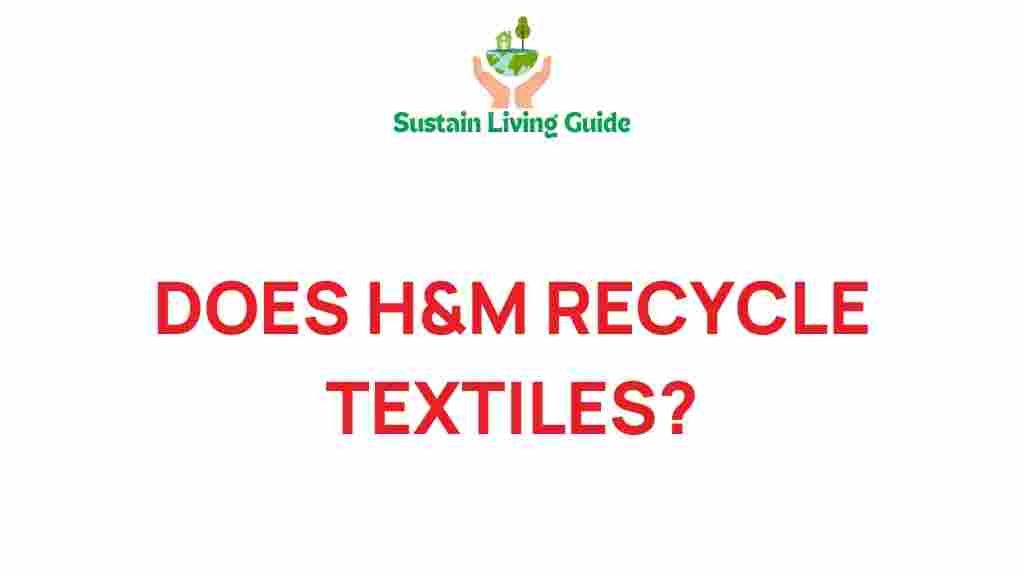H&M’s Textile Recycling: What Happens to Your Clothes?
In today’s fast-paced world of fashion, sustainability has become a critical concern for brands and consumers alike. H&M, a global leader in the fashion industry, is making strides to address this issue through its textile recycling program. This initiative not only aims to reduce textile waste but also seeks to educate consumers about the impact of their clothing choices. In this article, we will delve into H&M’s textile recycling process, what actually happens to your clothes, and why participating in this program can make a difference.
The Importance of Textile Recycling
With the fashion industry being one of the largest polluters globally, it’s imperative to understand the importance of textile recycling. Here are some key reasons why this practice is vital:
- Reduction of Waste: Millions of tons of textiles end up in landfills each year.
- Conservation of Resources: Recycling textiles conserves water, energy, and raw materials.
- Lower Carbon Footprint: Recycling helps to minimize greenhouse gas emissions.
H&M’s Commitment to Sustainability
H&M has committed to making fashion sustainable and circular. The brand aims to use 100% recycled or sustainably sourced materials by 2030. The textile recycling program is a significant step in this direction. But what happens to your clothes once you drop them off at an H&M store? Let’s break it down.
What Happens to Your Clothes at H&M?
When you bring your unwanted textiles to H&M, the process is systematic and efficient. Here’s a detailed look at the step-by-step journey of your clothes:
1. Collection
H&M has set up collection bins in their stores where customers can drop off their used clothing, regardless of the brand or condition. This is a convenient way for consumers to participate in textile recycling.
2. Sorting
Once collected, the clothes are sent to a sorting facility. Here, they are categorized based on their condition:
- Wearable Clothes: Garments that are still in good condition are cleaned and resold in second-hand stores.
- Repairable Clothes: Items that can be mended are sent to workshops to be refurbished.
- Unwearable Clothes: Textiles that cannot be repaired are processed for recycling.
3. Recycling Process
The recycling process involves breaking down the textiles into fibers, which can then be used to create new garments. Here’s how it works:
- Shredding: The fabrics are shredded into small pieces.
- Re-spinning: The shredded fibers are then re-spun into new yarn.
- Manufacturing: These new yarns can be woven or knitted into fresh fabrics for new clothing lines.
4. Final Product
The recycled materials are then utilized in the production of new H&M collections. This closes the loop in the circular fashion model, ensuring that your old clothes have a new life.
5. Awareness and Education
H&M not only recycles but also educates its customers about the importance of sustainable fashion practices. Through campaigns and in-store displays, they encourage consumers to think critically about their clothing purchases and disposal.
Challenges and Solutions
While H&M’s textile recycling program is commendable, it faces several challenges:
- Lack of Awareness: Many consumers are still unaware of the program.
- Contamination: Clothes must be clean and dry to be recycled effectively.
- Logistics: Efficient collection and sorting require significant resources.
To address these challenges, H&M is continuously working on:
- Marketing Campaigns: Increasing awareness through social media and advertising.
- Partnerships: Collaborating with local organizations to enhance collection efforts.
- Incentives: Providing discounts to customers who participate in recycling initiatives.
How to Participate in H&M’s Recycling Program
Participating in H&M’s textile recycling program is simple and rewarding. Here’s how you can do it:
Step 1: Gather Your Clothes
Collect any unwanted textiles you have at home. This can include:
- Clothing
- Accessories
- Shoes
- Home textiles (like curtains and towels)
Step 2: Visit an H&M Store
Find the nearest H&M store that has a recycling bin. You can check their website for locations.
Step 3: Drop Off Your Clothes
Simply drop your items in the recycling bin. Remember, you can recycle clothes from any brand!
Step 4: Get Rewarded
For every bag of clothes you recycle, H&M offers a discount coupon for your next purchase, making it a win-win situation.
Step 5: Spread the Word
Encourage friends and family to participate in H&M’s recycling program. The more people who get involved, the bigger impact we can make on reducing textile waste.
Troubleshooting Common Issues
While participating in the recycling program is straightforward, you might encounter some common issues. Here are some troubleshooting tips:
Issue 1: Not Sure What Can Be Recycled
If you’re unsure whether an item is recyclable, check H&M’s guidelines or ask a store associate for clarification. Generally, all textiles are accepted, but items should be clean and dry.
Issue 2: Finding a Store
If you’re having trouble locating a nearby H&M store, use their store locator tool on their website. You can also call customer service for assistance.
Issue 3: No Incentives Received
If you didn’t receive a coupon after dropping off your clothes, be sure to ask the store associate about the program. Sometimes, technical errors can occur.
Conclusion
H&M’s textile recycling program exemplifies how the fashion industry can strive for sustainability amidst rising consumer demand. By understanding what happens to your clothes after you drop them off, you can appreciate your role in this circular economy. Participating in H&M’s recycling initiative not only helps to reduce waste but also fosters a sense of community and responsibility towards the environment. Remember, every small action counts, and by choosing to recycle with H&M, you are contributing to a more sustainable future. For more information on H&M’s sustainability efforts, you can visit their official website here.
This article is in the category Eco-friendly and created by SustainLivingGuide Team
